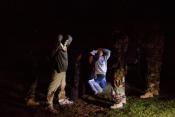Border crossing simulation offered at amusement park
Posted by: Jon on 06/27/2013 09:47 AM
[
 Comments
]
Comments
]
An amusement park in the the state of Hidalgo, Mexico, has a very unique hands on 'ride' that is being featured at Parque EcoAlberto. The 3 hour ride consists of a simulated border crossing complete with dogs, police, guns, and smugglers.
 PBS notes that the aim is to dissuade would be migrants from making the trip. The coyote, or smuggler, leading this simulated illegal border crossing used the name Simon and wore a face mask. Before setting off, he addressed his charges that evening, about 40 students from a private school in Mexico City.
PBS notes that the aim is to dissuade would be migrants from making the trip. The coyote, or smuggler, leading this simulated illegal border crossing used the name Simon and wore a face mask. Before setting off, he addressed his charges that evening, about 40 students from a private school in Mexico City.
"Tonight we're going to talk about migration," Simon said in Spanish. "But for us it isn't just something rhetorical, but rather the opposite. Because we have endured, we have suffered, of hunger, thirst, injustice, heat, cold, we have suffered from everything."
 Then, under the cover of night, Simon herded them into the woods, toward the fake frontera.
Then, under the cover of night, Simon herded them into the woods, toward the fake frontera.
The actual U.S.-Mexico border is nearly 800 miles away from the Parque EcoAlberto. The park is part of the indigenous HñaHñu community. Tourist can enjoy other recreational attractions like hot springs and rappelling, in addition to the recently added fake border crossing.
But for those who want to simulate the experience of fleeing across the border, without the real danger, the latter attraction is for you. For three hours, tourist groups endure sirens, dogs, chases and the fake border patrol yelling threats.
Maribel Garcia works as an administrator for the park. She says the purpose of the Night Walk is simple.
"Our objective is to stop the immigration that exists amongst our citizens, principally from the state of Mexico to the U.S.," Garcia said in Spanish.
The tours cost the equivalent of about $20. The visitors are typically middle-class Mexicans or, like tonight, students from private schools -- in other words, not the most likely group to attempt an illegal crossing into the U.S.
Still, there were some who had been thinking about it. Over tea and sweet breads at the end of the walk, Jazmin Arely Moreno Alcazar said she got the message.
"It's not worth risking it because if we can't stand a few hours, we won't be able to stand days. Because it's very ugly," Alcazar said in Spanish.
 PBS notes that the aim is to dissuade would be migrants from making the trip. The coyote, or smuggler, leading this simulated illegal border crossing used the name Simon and wore a face mask. Before setting off, he addressed his charges that evening, about 40 students from a private school in Mexico City.
PBS notes that the aim is to dissuade would be migrants from making the trip. The coyote, or smuggler, leading this simulated illegal border crossing used the name Simon and wore a face mask. Before setting off, he addressed his charges that evening, about 40 students from a private school in Mexico City."Tonight we're going to talk about migration," Simon said in Spanish. "But for us it isn't just something rhetorical, but rather the opposite. Because we have endured, we have suffered, of hunger, thirst, injustice, heat, cold, we have suffered from everything."
 Then, under the cover of night, Simon herded them into the woods, toward the fake frontera.
Then, under the cover of night, Simon herded them into the woods, toward the fake frontera.The actual U.S.-Mexico border is nearly 800 miles away from the Parque EcoAlberto. The park is part of the indigenous HñaHñu community. Tourist can enjoy other recreational attractions like hot springs and rappelling, in addition to the recently added fake border crossing.
But for those who want to simulate the experience of fleeing across the border, without the real danger, the latter attraction is for you. For three hours, tourist groups endure sirens, dogs, chases and the fake border patrol yelling threats.
Maribel Garcia works as an administrator for the park. She says the purpose of the Night Walk is simple.
"Our objective is to stop the immigration that exists amongst our citizens, principally from the state of Mexico to the U.S.," Garcia said in Spanish.
The tours cost the equivalent of about $20. The visitors are typically middle-class Mexicans or, like tonight, students from private schools -- in other words, not the most likely group to attempt an illegal crossing into the U.S.
Still, there were some who had been thinking about it. Over tea and sweet breads at the end of the walk, Jazmin Arely Moreno Alcazar said she got the message.
"It's not worth risking it because if we can't stand a few hours, we won't be able to stand days. Because it's very ugly," Alcazar said in Spanish.
Comments






